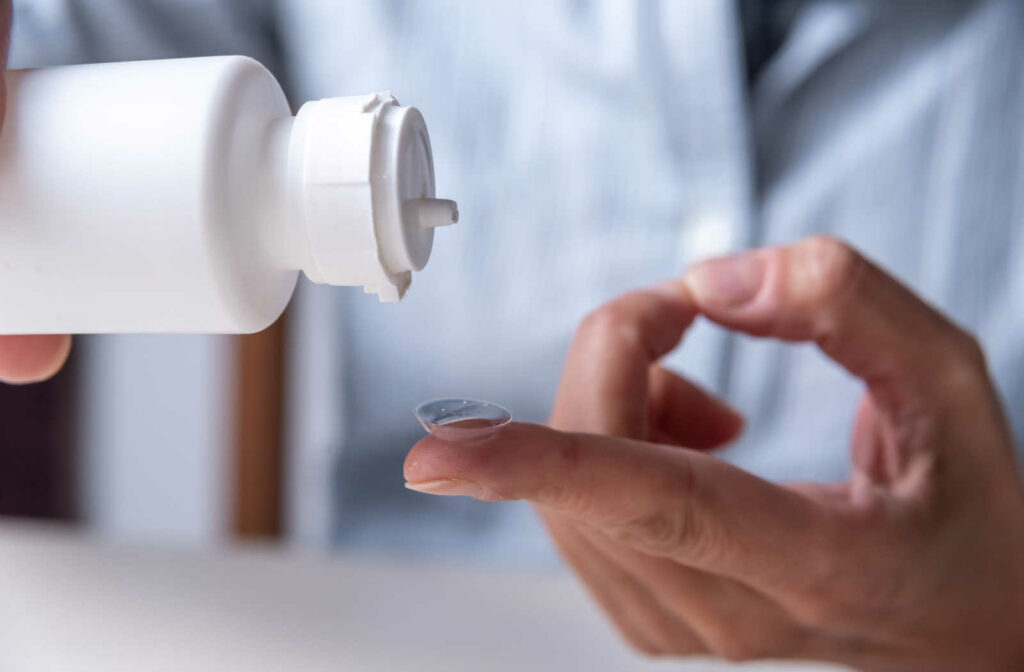Table of Contents

Introduction
As a contact lens wearer, dealing with dry eyes can be frustrating. You’re not alone in this struggle, as dry eye disease is a common issue often aggravated by contact lenses. You do not need to give up on your contacts.
Some options include for managing dry eyes while wearing contacts include:
- Working with your optometrist to identify potential causes and develop a personalized plan.
- Using daily disposable lenses.
- Maintaining proper contact lens care.
- Attending regular eye exams.
- Making environmental adjustments.
We’re here to help you understand and manage dry eye while continuing to reap the benefits of wearing contact lenses.
What Is Dry Eye Disease?
Dry eye disease is sometimes temporary, such as when it’s caused by environmental factors or health problems, such as wind exposure or poor sleep. However, it’s often a chronic problem that requires more than just a few eye drops to resolve. Identifying the root cause of dry eye is essential for recommending the right treatment.
This condition is primarily caused by poor-quality tears or a lack of sufficient tears, which can result from reduced tear production, increased tear evaporation, or imbalances in the composition of the tears. Tears are crucial in protecting and nourishing the cornea (the front part of the eye).
The tear film is comprised of 3 layers:
- The inner mucus layer that anchors the tears to the eye.
- The watery middle layer that keeps the eye hydrated and clean.
- The oily outer layer that prevents evaporation and maintains a smooth eye surface.
Dry Eye Symptoms
Those with dry eyes can experience symptoms such as a gritty sensation or the feeling of something in the eye.
In some cases, dry eyes can lead to excessive watering if the eye tries to compensate for poor-quality tears by producing more. If left untreated or if it becomes severe, advanced dry eyes can damage the cornea and impair vision.
Other common symptoms include:
- Blurry vision
- Burning or stinging sensations
- Light sensitivity
- Redness
- Stringy mucus
What Causes Dry Eye Disease?
Various causes can gradually accumulate and worsen the problem of dry eyes. Some prominent risk factors include:
- Age: As we grow older, our eyes produce fewer tears. Those above 65 are more prone to dry eye symptoms.
- Environmental conditions: Exposure to smoke, wind, or dry climates can cause tear evaporation. Moreover, extended computer use may affect your blink rate, leading to digital eye strain.
- Hormonal changes: Hormonal fluctuations during menopause or pregnancy can impact tear production.
- Medical conditions: Certain health issues can influence tear production and result in ocular symptoms such as dry eyes. Autoimmune disorders and eye health problems like blepharitis and meibomian gland dysfunction (MGD) can also contribute to dry eyes.
- Medications: Some drugs, including antihistamines, decongestants, blood pressure medications, and antidepressants, can reduce tear production.
- Refractive eye surgeries: Dry eyes can be a side effect of eye surgeries like LASIK.
How Do Contacts Affect Dry Eyes?
Contact lenses can worsen dry eye symptoms since they restrict the amount of oxygen that reaches the cornea, disturbing the tear film. It increases tear evaporation and decreases tear production, making the eyes feel dry and uncomfortable.

How to Treat Dry Eye Disease for Contact Lens Wearers
Optometrists can evaluate your eye health and consider your lifestyle to pinpoint the potential causes of your dry eyes. Once they establish a plan, they can recommend suitable dry eye solutions for your eye care needs.
Managing dry eyes may involve a mix of clinical treatments and ocular hygiene habits, ranging from LipiFlow and digital screen breaks to prescription medications and over-the-counter artificial tears.
Other ways you can manage dry eye while wearing contact lenses include:
Daily Disposable Lenses
One option is to switch to daily disposable contact lenses. These lenses are designed to be worn for a single day and discarded, reducing the risk of irritation and dryness. They also eliminate the need for cleaning solutions, which can sometimes contribute to dry eye symptoms.
Proper Contact Lens Care
Taking care of your contact lenses is crucial in managing dry eye symptoms. Clean and store your lenses properly, and always replace them according to your optometrist’s and the manufacturer’s recommendations. Additionally, consider using a contact lens solution specifically designed for sensitive eyes.
Regular Eye Exams
Regular eye exams are essential for maintaining your eye health and making sure that contact lenses fit your eyes correctly. Your optometrist can also evaluate your dry eye condition and recommend appropriate treatments.
Environmental Adjustments
Making some changes to your environment can also help manage dry eye symptoms. For example, use a humidifier to add moisture to the air and take frequent breaks from looking at screens.
Taking Control of Your Dry Eye Situation
At Golden Vision Optometry, we believe in a comprehensive approach to dry eye care. We understand that there is no universal solution for dry eye disease, so we collaborate with each patient to develop a customized plan tailored to their unique needs.
Our dry eye solutions take into account your symptoms and their impact on your daily life. We offer a Dry Eye Spa experience, allowing you to relax and rejuvenate while finding dry eye relief. By combining medical treatments, lifestyle adjustments, and hygiene products, we aim to help you achieve clear and comfortable vision for years to come. With numerous available treatments, our experienced team can diagnose and treat your condition, offering lasting relief.
Dry eye disease may be frustrating, but it doesn’t have to be a permanent burden. At Golden Vision Optometry, our goal is to help your vision achieve its full potential. Book an appointment today.

